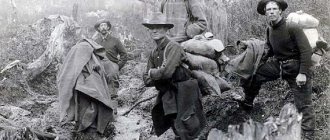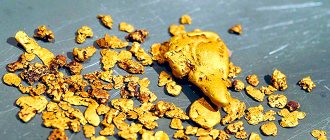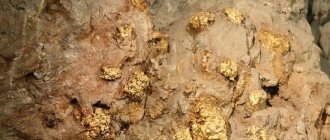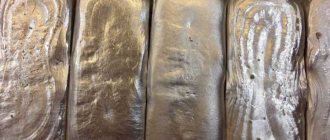The Ural region is rich in many different minerals. Gold is also found here, which is mainly found in deep mines. There are small and large deposits of the precious metal in the region. Gold mining in the Urals using artisanal methods, according to maps, has been going on for more than one century. The oldest deposit of this metal is hidden in the local mountains. Today, both large companies and private miners are looking for aurum.
Place of Birth
The high popularity of gold mining in the Urals is due to many factors. This region attracts prospectors for the following reasons:
- moderate climatic conditions allowing the extraction of gold-bearing veins within several months;
- absence of permafrost layers, which create additional problems during ore mining;
- successful gold deposits in terms of geographical location.
Gold mining in the Urals is carried out in several ways:
- Handmade or artisanal. Basically, prospectors use the gold-bearing rivers of the Urals to extract metal.
- Ore. Extraction is carried out in mines.
- Use of dredge. In this case, the rivers of the Urals are also used.
- Hydraulic.
Due to the fact that this region contains rich deposits, the ore method is used to extract metal. Examples of local ore deposits are summarized in the table below. This is a kind of map that indicates where to look for gold in the Urals.
| Type of deposit | Peculiarities | Examples of deposits |
| Indigenous | Vein and mineralized zones occur in the Urals. | Koncharskoye, Svetlinskoye, Kurosan (southern and western), Nailinskoye |
| Placers | They are a gold-bearing mass that has accumulated in one place through the transfer of ore and rock by water. | Bolsheshaldinskaya placer, Moss swamp. |
According to experts, up to 15% of the world's gold reserves are hidden in the Ural region. Analysts predict that if current production volumes are maintained, the precious metal will last for about 100 years.
The Urals are one of the richest sources of minerals. The region contains many deposits of precious metals, which are mined by both manual and industrial methods.
Primary deposits
In the Urals, gold is mined from the following types of deposits:
- vein;
- mineralized, in which, in addition to gold-bearing veins, other inclusions are found.
The Ural vein deposits, depending on the composition and depth of occurrence, can be divided into:
- quartz (up to 15 meters);
- sulfide (located at a depth of up to 2 meters);
- easily enriched, when deposits of gold ore are located almost on the surface.
When mining gold in the Urals using the artisanal method, it is recommended to select maps that contain an indication of the location of quartz. This is explained by two reasons:
- Quartz is one of the most common minerals.
- It is often adjacent to gold-bearing rocks.
These minerals come in different colors. If the discovered quartz contains empty cavities, this will facilitate further search for gold.
The presence of such formations indicates that inclusions of noble metal were previously found in the mineral. Accordingly, it can be found if you excavate neighboring veins.
Quartz deposits are among the most attractive. The fact is that they contain so-called native gold with a minimal amount of foreign inclusions. Moreover, in most cases, the metal contains inclusions of silver.
On the territory of the Ural Mountains, which lie only in the Orenburg region, about 150 gold deposits have been discovered. Private prospectors can try their luck on rivers located near:
- Kirovsky (Kvarkensky district);
- Aydyrlinsky (not far from the village of the same name);
- Blakskoe deposits (Svetlinsky district).
In all these areas, the precious metal is mined industrially. In particular, near the village of Aydyrlinsky, gold lies at a depth of more than 100 meters. From the point of view of a private miner, the Ural rivers and local placers will be the most attractive for ore extraction.
Nizhny Tagil district
In the Nizhny Tagil region, nuggets were found on the Ashka River, a tributary of the Mezhevaya Utka, on the Serebryanka River and its tributaries. On the Malaya Telyanya River there were nuggets weighing up to 2.4 kg.
From the Nizhny Tagil region, G. Rose described an octahedral gold crystal. According to the analyzes of G. Rose (1836-1842), the gold sample from two placers in the Nizhne Tagil region was 87 and 90-91-94.
In the Verkhne-Tagil region, at the Aleksandrovsky mine, gold nuggets weighing up to 5 kg were encountered.
Placers
Gold placers in the Urals are located in areas located:
- near Magnitogorsk and Tagil;
- on the eastern part of the mountain range;
- in the central part of the Urals.
The upper reaches of the Suunduk River deserve special attention. It flows along the Ural mountains through the territory of the Orenburg region. At the same time, the upper layers of local placers have long been worked out. Currently, the development of layers that lie deep underground is underway.
Mostly alluvial placers are found here. They are formed due to the gradual transfer of rock mass, which includes gold veins. Such placers are often located in river valleys. In such deposits the gold is well rounded. That is, the metal is presented in the form of grains with clear edges.
Gold-bearing layers in the territory of the Ural placers are often concentrated in a certain zone. The maximum length of such deposits reaches 5 kilometers. Precious metal in local placers usually lies at a depth of 10 meters. There are also upper layers (1-3 meters) and deep layers (up to 60 meters).
The concentration of gold in placers varies. It varies from 0.01 to several milligrams in each cubic meter of mined ore material. Whole nuggets are also found in the Ural Mountains.
The attractiveness of local placers, from the point of view of private miners, is due to several factors. Firstly, there are more than one hundred of these deposits in the Urals. Secondly, they are formed by erosion of rock, due to which gold-bearing layers are formed on the river bottom. You can also look for metal in the area of the old riverbed. In other words, in the area where the river used to flow.
Placers in the Urals are a rich source of gold. Such deposits are found in various areas of the Siberian mountains, both close to populated areas and at a considerable distance from them.
Pervomaisky village and ancient mine
If you drive a little further along the road, the small village of Pervomaisky begins. At the entrance to it, the so-called “author’s” village “Severnaya Sloboda” is being built.
, the Mostovsky gold mine arose here . Residents were engaged in artisanal fishing. Thus, a new settlement gradually grew, which later received the name Pervomaisky. The Pervomaisky Klyuch river flows through it.
In 1877, a chapel was built here. In 1881, it was rebuilt into a single-altar wooden church , consecrated in the name of St. Nicholas the Wonderworker. It is interesting that the iconostasis for her was purchased from the church in the village of Gornoshchitsky. In 1885, a parish school was opened in the village. In 1930, the church was closed and the dome and bell tower were demolished. The building was given over to the club, thanks to which it has survived to this day. According to the 2010 census, only 68 people lived in the village of Pervomaisky.
In the forest, about a hundred meters east of the outskirts of the village, you can see an ancient mine. There are several small quarries and pits here. The site is noted on Wikimapia as a chromite mine .
Where to search
As an example of the Ural placers, two of them can be cited:
- Bolsheshaldinskaya;
- Moss swamp.
The Bolsheshaldinskaya placer has been mined for about two centuries. According to research conducted by a Soviet geologist, this deposit is located near primary sources. At the Bolsheshaldinskaya placer there are both small inclusions of gold-bearing mass and whole nuggets. Moreover, the first ones occur most often.
Alluvium (rolled) materials are hidden in the local area under clay and a black marshy layer. Almost all sediments here contain gold. The exception is floodplains.
The following minerals are found at the Bolsheshaldinskaya placer:
- magnetite;
- titanite;
- pyrite;
- monazite;
- rutile and others.
If for some reason a prospector was unable to find a map of the Ural deposits, these minerals will make the search for gold-bearing layers easier. The precious metal that the Bolsheshaldinskaya placer contains is one of the purest. It contains only silver in small concentrations.
The moss swamp is located in the Southern Urals, in the Chelyabinsk region. There are also primary deposits with a high content of quartz and sulfide. According to the results of the surveys, for every ton of rock collected in the Moss Swamp, there are up to 1-10 grams of gold and 10-13 (even 50-100 are detected) grams of silver.
Also, research data indicate that the precious metal is presented here in the form of intergrowths with quartz or individual nuggets. The largest “ingot” found in the Moss Swamp weighed 94 grams.
Both placers are rich sources of gold. They contain small and large inclusions of high-grade noble metal.
Sverdlovsk district
In the Sverdlovsk region, in many areas, not only rounded nuggets, but also gold crystals were extracted from placers (Rose, 1881).
At the Pervomaisky mine on the Klyuch River north of the Berezovsky mine, gold was mined almost exclusively in the form of nuggets weighing several tens, often hundreds of grams.
At the Mostovsky site, clearly defined crystals, dendrites and lamellar forms of gold were encountered. The forms of intergrown crystals of octahedrons and rhombic dodecahedrons were not uncommon, but dendrite-like and thick-wire forms were more often found. Most of these samples are mentioned in the catalog of the museum of the Leningrad Mining Institute, compiled by A. V. Kupffer (1911).
In the area of the Berezovsky plant, a wide variety of very interesting crystalline forms of gold were observed, also described in the catalog of A. V. Kupffer.
G, Rose (1831) described a rhombohedral crystal of gold from the vicinity of Sverdlovsk. Gold from the Sverdlovsk region has always been distinguished by its high fineness (92-95). In the Shabrovo placer, a lot of nuggets were mined with an exceptionally high purity - 98 (analysis by Rose, 1831) with a silver content of only 0.16%, copper 0.35% (Ivanov, Perelyaev, 1941).
How gold is mined
In the Urals, traditional technologies are used for gold mining using:
- Industrial device. It is not recommended to use industrial equipment for gold mining in the Ural Mountains. The fact is that such an installation traps fairly large particles of metal. However, in local placers, the material is often either included in other minerals or has very small sizes. In addition, Ural gold is hidden under a layer of clay and heavy soil. In Soviet times, devices were used at local deposits that could capture particles ranging in size from 0.5 to 80 mm. Moreover, even the use of such equipment did not exclude numerous losses. According to researchers, industrial devices released up to 15-40% of the gold mass back into the soil. And particles no larger than 0.25 mm in size were not recovered at all. Experts believe that with minimal investments and the organization of small enterprises, up to 7 tons of gold can be extracted annually from already developed Ural deposits.
- Minidrag. Minidrags are autonomous installations through which river sands are washed in order to extract gold particles from them. These devices include pumps that supply the material. Mini dredges are used in various placers and flooded areas where gold-bearing masses may potentially occur.
- Minigates. Mini-sluices have a design similar to mini-drags. The difference in the design of both devices is that the latter are mounted on pontoons. Mini-gates are installed on the banks of gold-bearing rivers. These devices, through a flexible hose, suck in sand, which is fed to a hydraulic screen, where the material is initially purified from impurities. Mini-sluices are also used in dry areas containing gold-bearing strata.
- Metal detector. Another device that private miners use in their work. Depending on the characteristics of the metal detector, it is capable of detecting gold inclusions in the soil layer at a depth of up to 50 cm. Some devices are equipped with a disintegrator that determines the type of mineral rock.
Novice miners also use special trays for washing gold-bearing sand in rivers.
Polevsky district
In the Polevsky region, in placers along the Zyuzelsky ravine in the Chusovaya River basin, exceptionally interesting gold crystals were found, described by Helmhacker in 1877.
Here, on December 15, 1935, a gold nugget weighing 13.8 kg was found. It was discovered by a team of prospector Paltsev in Nikolsky Log, a right tributary of the Chusovaya River, 1.5 km northwest of the village of Kosoy Brod.
The nugget has the appearance of a thick, oblong, as if crumpled plate 38 cm long, 8-13 cm wide and 1.5-6 cm thick. The color is dull yellow, in places with a reddish-brownish tarnish. The planes and lateral edges are smooth, only in the longitudinal depressions the tuberosity is preserved, which indicates long-term grinding of the nugget with sand and pebble placer material. The nugget lay at a depth of 4 m on a raft of weathered siliceous-mica-carbonaceous shales of a dark brown color. Despite the overall high content, small nuggets weighing up to 12 g were also found in the placer.
In addition to the nuggets, which were distinguished by their strong roundness, the placer also contained small gold, distinguished by slight polishing in the form of irregularly shaped grains and rough tablets. The reason for the co-presence of two morphological varieties of gold remains unclear.
The origin of the main nugget is unclear, but since its horizontal movement was undoubtedly short, it is customary to associate it with abundant end gold-bearing veins on the right side of the Nikolsky Log placer. The discovery of the nugget is essentially accidental, since it was discovered in the side of the placer 50 years after the mining of the site, and therefore it can be assumed that in addition to it, other large nuggets remained in the side pillars that had not previously been mined due to the low content of fine gold in them.
Recommendations for working with a metal detector
If in the case of mini-dredges and mini-sluices it is initially clear how to choose a place for future mining, then when working with a metal detector it is recommended to go to the territory where nuggets weighing more than 50 grams were previously found. This device simply will not detect small gold particles. You can find out in which region relatively large nuggets were previously discovered from geologists or at the local library.
Quite often, large particles of gold are localized in a separate area, forming so-called nodes. Accordingly, once found, a nugget will most likely lead to other large-sized precious metals. It is important to understand that in most cases such deposits have been previously mined. However, during mining, some of the minerals often remain in the ground.
The search for gold-bearing masses in the Urals is carried out on:
- new areas;
- technogenic (spent) placers.
The most preferable search is in new areas. It should be noted that work in such territories often leads to unsatisfactory results. On the other hand, there is a possibility that a small gold mine may be discovered. In addition, there are many unexplored areas in the Urals that could potentially hide precious metals.
Working on technogenic placers is suitable for those who, first of all, want to extract gold. Such areas always contain several grams of precious metal. However, a prospector in technogenic placers will not be able to extract gold in significant quantities.
Historical reference
The Urals is the place where gold was discovered for the first time in Russia and the first mine started working. Unsuccessful searches for gold had been undertaken before, but only in 1745 Erofei Markov found a strange stone with gold inclusions and went with it to Yekaterinburg. He almost paid with his life for his discovery, since mining engineers did not find the precious metal at the place he indicated and suspected him of lying. However, Lomonosov's student, Ignatius Yudin, discovered particles of gold in the ore and in 1747 the first mine of the Berezovsky mine was founded.
Thus, Russia not only acquired its own gold, but also became the only state in the world where the extraction of precious metals begins not from alluvial deposits, but from ore deposits. However, the mine did not immediately begin to bear tangible fruits - the first data on the mined 16 pounds of gold are dated 1754.
First major finds
Exploration for gold deposits continued and by the end of the 18th century, about 140 gold-bearing veins had been identified and dozens of mines had been built. On one of them, in 1842, the largest Russian nugget was found, called the “Big Triangle,” weighing more than 32 kilograms.
But the real gold rush begins with the discovery of deposits of placer gold, which experienced prospector Lev Brusnitsyn purposefully searched for and found on the banks of the Berezovka River.
Not only did he discover a deposit with an easy and inexpensive manual mining method, but he also developed a soil-washing device known as a borehole, or "American", which was subsequently widely used in the mines of California and Alaska.
Search in waste placers
When choosing an area of technogenic placers to search for gold-bearing veins, it is recommended to pay attention to areas located near the headwaters of rivers. This is explained by the fact that large particles of precious metal are poorly transported by water flows. Therefore, they accumulate near the gold-bearing vein. In the lower reaches, mostly small gold is found.
Individual nuggets may be found in these areas. But discovering such zones seems to be a rather difficult task, requiring patience and luck from the prospector. Beginner gold miners are advised not to go further than 2 km from the source of the river.
When searching, you should pay attention to areas where bedrock is exposed. It is best to mine the material immediately after industrial mining has ended at the site. This is explained by the fact that even with highly efficient equipment and complete clearing of the territory, there remain cavities that have preserved gold.
So, when searching for precious metal in technogenic placers, you should select areas:
- where commercial production has recently completed;
- they are located in the upper reaches of rivers;
- deposits include relatively large gold.
In cases where the carpenter is completely closed, you can use a metal detector to look for gold in sand dumps. Quite often in such formations, nuggets are found together with quartz.
Working with dumps is more difficult. They contain a lot of small metal debris.
Isovsky district
In the Isovsky region on the Nyasma River, Lyali River system, cases of nugget finds are also known: in 1934, a nugget weighing 22.2 g was found; in 1936, three nuggets carried 47.2, 28.5 and 85.5 g.
According to archival data, nuggets weighing 400 g or more were found here.
To the south, in the placers of the Severnaya, Yegoryevka, Petrovka, Vargarinka and other rivers flowing into the Poludenka and Tiskos rivers of the Koiva River system, gold was distinguished by the size of gold particles. The placer on the Shaldinka River, a tributary of the Koiva River, was distinguished by a significant content of nuggets, in which the amount of metal in nuggets larger than 1 g was about 19%. During exploration, nuggets weighing up to 12 g were encountered, and during exploitation, nuggets weighing up to 30 and 100 g.
In the Predatory Log (the right tributary of the Ayva River, system of the Salda River) in 1934, a plate-shaped nugget weighing 1800 g and measuring 21x9x0.8 cm was found. The placer of the Salda River was also distinguished by the presence of nuggets that made up at least 13% of the total gold content.
Small nuggets were found in placers of the Bol Namenaya River and its tributaries, the Chekmenya and Lomovka rivers, in quantities of 1 to 8% for the former and 17.5% for the latter. In the placers of the Talaya River, a tributary of the Is River, and the Roga River, a left tributary of the Vyi River, nuggets weighing from 1 to 100 g were often found.










